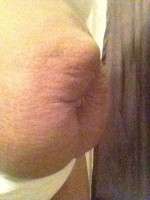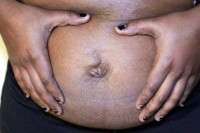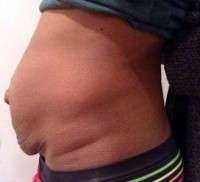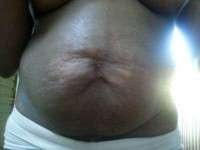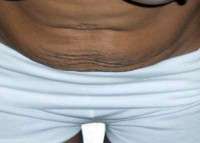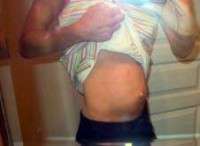Hernia repair and tummy tuck
Tummy tuck and umbilical hernia repair
I would recommend you get a second opinion from a board certified plastic surgeon. Your c-section could be opened, exposing the abdominal muscles and the umbilical hernia.
Sutures would then be placed to correct the diastasis by pulling the abdominal fascia tighter. Sutures could then be placed to close the umbilical hernia.
The umbilicus would then be “floated” and the excess skin advanced downward and excised. If you don’t have that much excess skin, you could remove as much as safely possible and still flatten your tummy. Again I would recommend another opinion. (Stanley Castor, MD, Tampa Plastic Surgeon)
Rectus Diastasis and Umbilical Hernia Repair
There are several variations of a tummy tuck designed to correct almost any abnormal abdominal wall skin/fat/muscle combination. Patients with rectus diastasis (separation) and an umbilical hernia can undergo a full tummy tuck or variation of one where the belly button is divided to allow correction of the hernia and loose muscle (floating belly button technique) and then repaired.
Most plastic surgeons feel more than qualified and trained to address these types of issues. It may be that your plastic surgeon does not performthis type of muscle repair or hernia repair. I feel it is important for every patient to seek out at least 3 consultations from Board Certified Plastic Surgeons to help make the best informed decision. I wish you a safe and healthy tummy tuck recovery. (Paul S. Gill, MD, Houston Plastic Surgeon)
Tummy Tuck to Fix Umbilical Hernia and Abdominal Muscles
Tummy Tuck can fix “tron abdominal muscles” and repair separation of the abdominal muscles. Usually after several pregnancies there is enough skin loosness when a tummy tuck can be performed sucessfully. (S. Sean Younai, MD, FACS, Beverly Hills Plastic Surgeon)
It’s not surprising that you have developed an umbilical hernia, a rectis diastasis, and weakened abdominal muscles following five pregnancies. However, it is a surprise that you reportedly haven’t developed accompanying loose, saggy abdominal skin following these pregnancies.
In this situation, you may not have loose skin, but I’m inclined to believe that there is probably loose skin present and this was not recognized by your surgeon. During pregnancy, the abdominal wall becomes stretched by the rapid expansion of the intra-abdominal contents. In many cases, this results in separation of the two muscles in the midline with formation of a diastasis and possibly an umbilical hernia.
This separation extends from the pubis to the rib cage, and is especially noticeable when the abdominal muscles are flexed. Flexion typically results in a midline bulge that extends from the rib cage to the pubis. It’s important to realize that the forces that cause torn abdominal muscles and hernia formation usually create redundant abdominal wall tissue as well.
Correction of a diastasis recti and associated umbilical hernia involves suture repair of this gap from the rib cage to the level of the pubic bone. This repair requires exposure of the underlying muscle by separating it from the overlying skin and subcutaneous tissue. If significant excess skin is present at this point, the procedure can be easily completed by performing an abdominoplasty.
If lesser amounts of excess skin are present, than a modified abdominoplasty technique can be utilized with excellent tummy tuck results. Under these circumstances, a second opinion would not be considered unreasonable. (Richard J. Bruneteau, MD, Omaha Plastic Surgeon)
Repair of hiatal hernia and diasthesis recti and tummy tuck
For a person who does not have too much excess skin, however has umbilical hernia and significant separation between abdominal muscles, due to multiple pregnancies, a modified tummy tuck could address the concerns. It is not necessary to make a long , hip to hip , incision to have access to the abdominal wall. Through this limited incision the umbilical hernia could be fixed and diasthesis recti be repaired. Superficial liposuction would moderately thigthen the skin and redundant skin could be excised. Obtaining an alternative opinion from an experienced plastic surgeon would definitely be helpful. (Fereydoon S. Mahjouri, MD, Minneapolis Plastic Surgeon)
Hernia repair and tummy tuck
If you have an umbilical hernia and a weakened abdominal wall, these can both be addressed during a tummy tuck procedure. If you have a true abdominal hernia, you may require a hernia repair with mesh at the same time which can be done with a general surgeon or by your plastic surgeon.
This is difficult to answer without examining you so I would advise seeing several different plastic surgeons before undergoing surgery.Best wishes,Dr.Bruno (William Bruno, MD, Beverly Hills Plastic Surgeon)
It is very difficult to tell without seeing how much excess of skin you have. For many patients a mini tummy tuck will help along with abdominal muscle repair.
The hernia should be repair at the same time. (Jhonny Salomon, MD, Miami Plastic Surgeon)
If you do not have a large amount of skin, a mini tummy tuck can be performed in conjunction with a hernia repair and muscle tightening. A plastic surgeon typically does the entire procedure. (Christopher J. Davidson, MD, FACS, Wellesley Plastic Surgeon)
It is possible to have the hernia repair and the rectus diastasis repaired.
If you don’t have enough loose skin for a full tummy tuck then you would have repair of the hernia and the diastasis but only a mini-tummy tuck for the skin part of the surgery. So it sounds like you don’t have enough loose skin to have a full tummy tuck. You will have an incision around your umbilicus as well as the bikini line scar. (Leila Kasrai, MD, FRCSC, Toronto Plastic Surgeon)
